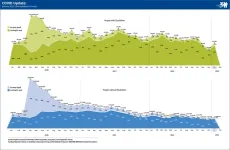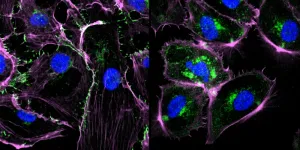(Press-News.org) BOSTON – In people with type 1 diabetes, the body’s immune system attacks and destroys insulin-producing β cells that control blood glucose levels and are part of a group of cells in the pancreas called pancreatic islets. In research published in Cell Reports Medicine, a team led by investigators at Massachusetts General Hospital (MGH), a founding member of Mass General Brigham, recently developed an efficient way to transplant pancreatic islets and demonstrated that the method can effectively reverse type 1 diabetes in nonhuman primates.
Pancreatic islet transplantation is a promising treatment approach for type 1 diabetes; however, current methods, which involve transplanting islets to the liver, are inefficient and can result in the loss of as much as half of transplanted β cells due to immune attack. Also, the liver can only accommodate a limited volume of transplanted tissue. Scientists have wondered if an alternative site might provide a more hospitable environment and lead to better results. One promising site is the omentum, the fatty tissue that starts in the stomach and drapes over the intestines.
To optimize the omentum as a transplant site in an individual, investigators used topical recombinant thrombin (which stops bleeding), an enzyme, and the recipient’s own plasma to engineer a bio-degradable matrix by which donor islets are immobilized onto the omentum. When this strategy was used along with an immunosuppressive therapy to protect islets from immune attack, the method normalized blood glucose levels and restored glucose-responsive insulin secretion in three nonhuman primates with type 1 diabetes for as long as the animals were tested. “The achievement of complete glycemic control is attributed to the bioengineering approach that facilitates the process of revascularization and reinnervation for the transplanted islets,” says first author Hong Ping Deng, MD, MSc, a researcher of Transplant Surgery at MGH. “which is the first time that such a demonstration has been made in a nonhuman primate model.”
“This pre-clinical study can inform the development of new strategies for β cell replacement in diabetes and could change the current paradigm of clinical pancreatic islet transplantation,” says senior corresponding author Ji Lei, MD, MBA, MSc, a principal physician investigator of Transplant Surgery at MGH and an assistant professor of Surgery at Harvard Medical School. “A clinical trial is being planned to test this approach.”
Lei, who is also the director of the Human Islet/Cell Processing Special Service cGMP Facility at MGH, notes that in addition to transplanting islets from donors, researchers are also studying the potential broad application of transplanting stem cell–derived islets, which cured a patient with type 1 diabetes for the first time in human history in 2022 and could offer an endless supply of transplantable tissue. There are concerns about this approach, however, including the possibility of tumor development. Unlike the liver, the omentum is easily accessible for monitoring purposes, and its non-vital site status can allow for the removal of transplanted tissue should complications occur, with either stem cell–derived islets or islets from donors. In addition, the engineered omental site can be home to many other types of genetically engineered cells, especially for liver-based or inherited metabolic or endocrine disorders.
Co-author James F. Markmann, MD, PhD, chief of the Division of Transplant Surgery and director of Clinical Operations at the Transplant Center at MGH, stresses that the non-human primate study is a highly translational pre-clinical animal model. “The application of this strategy, particularly in stem cell–based therapy, has the potential to revolutionize the paradigm for treating patients with type 1 diabetes,” he says.
Additional co-authors include Alexander Zhang, Dillon Ren Rong Pang, Yinsheng Xi, Zhihong Yang, Rudy Matheson, Guoping Li, Hao Luo, Kang M. Lee, Qiang Fu, Zhongliang Zou, Tao Chen, Zhenjuan Wang, Ivy A. Rosales, Cole W. Peters, Jibing Yang, María M. Coronel, Esma S. Yolcu, Haval Shirwan, and Andrés J. García.
This work was supported by the Juvenile Diabetes Research Foundation, and the National Institutes of Health.
About the Massachusetts General Hospital
Massachusetts General Hospital, founded in 1811, is the original and largest teaching hospital of Harvard Medical School. The Mass General Research Institute conducts the largest hospital-based research program in the nation, with annual research operations of more than $1 billion and comprises more than 9,500 researchers working across more than 30 institutes, centers and departments. In July 2022, Mass General was named #8 in the U.S. News & World Report list of "America’s Best Hospitals." MGH is a founding member of the Mass General Brigham healthcare system.
END
Researchers bioengineer an endocrine pancreas for type 1 diabetes
Transplanting donor islet tissue to a bioengineered omentum—the fatty tissue that drapes from the stomach over the intestines—normalized blood glucose levels in nonhuman primates with type 1 diabetes.
2023-03-01
ELSE PRESS RELEASES FROM THIS DATE:
New UCF project seeks to advance human understanding of AI reasoning
2023-03-01
ORLANDO, March 1, 2023 — A University of Central Florida researcher has received funding from the U.S. Department of Energy (DOE) to enhance the current understanding of artificial intelligence (AI) reasoning.
The project focuses on developing algorithms to create robust multi-modal explanations for foundation, or large, AI models through the exploration of several novel explainable AI methods. The DOE recently awarded $400,000 to fund the project.
The project was one of 22 proposals selected for the DOE’s 2022 Exploratory Research for Extreme-Scale Science (EXPRESS) grant, which promotes the study ...
New study reveals parents’ concerns about their sexual and gender minority teens using prep for HIV prevention
2023-03-01
Since its approval in 2012, HIV pre-exposure prophylaxis, or PrEP, has shown promise in reducing HIV infection rates by preventing infection in high-risk HIV-negative people. However, research shows that only around three percent of sexual and gender minority (SGM) adolescents who are eligible for PrEP have used it.
In a new study, Christopher Owens, PhD, assistant professor in the Department of Health Behavior at the Texas A&M University School of Public Health, explores factors that may be associated with parents’ acceptance of their SGM adolescent using PrEP. The study, published in the journal AIDS ...
New mathematical model shows promising results for prostate cancer treatment
2023-03-01
A new mathematical model which aims to optimise treatment for prostate cancer has been developed by experts at the University of Portsmouth.
Prostate cancer is the second most common cancer among men worldwide and accounts for 26 percent of all new cancer cases in males in the UK.
Over the past few decades mathematical models of tumour growth have been used to better understand the disease, to make predictions and to guide new experiments and clinical trials.
Dr Marianna Cerasuolo, Senior Lecturer from the University’s School of Mathematics and Physics, ...
nTIDE February 2023 Deeper Dive: What’s driving historic highs for employment of people with disabilities?
2023-03-01
East Hanover, NJ – March 1, 2023. In this month’s nTIDE Deeper Dive Lunch & Learn Webinar we explored the factors underlying the unprecedented rise in the employment of people with disabilities during the COVID-19 pandemic while continuing to follow trends in the labor market. This webinar followed two key unemployment indicators–the number unemployed and the proportions of unemployed persons that are on temporary layoffs (i.e., furloughs), comparing trends for people with and without disabilities.
“In January, we saw a large increase in the proportion ...
Study forecasts tile drainage and crop rotation changes for nitrogen loss
2023-03-01
URBANA, Ill. – Midwestern agriculture contributes the vast majority of nitrogen in the Gulf of Mexico, causing an oxygen-starved hypoxic zone and challenging coastal economies. State and federal policies have tried for decades to provide solutions and incentives, but the hypoxic zone keeps coming back. A recent study from the University of Illinois offers a new way to understand Midwestern nitrogen dynamics and forecasts future nitrogen loads under various management scenarios across the region.
“Our model explains what's going on across 83 watersheds in the Midwest, providing a quantitative understanding of why certain watersheds ...
Vilcek Foundation announces open call for $150,000 in prizes to immigrant scientists
2023-03-01
In 2024, the Vilcek Foundation will award three Vilcek Prizes for Creative Promise in Biomedical Science of $50,000 each. The prizes recognize and celebrate the contributions of rising immigrant scientists in the United States whose work represents a significant contribution to their field. The Vilcek Foundation is hosting an open call for applications for the 2024 prizes; applications will be accepted through June 12, 2023, at 5:00 p.m. ET.
The Vilcek Prizes for Creative Promise are a part of the Vilcek Foundation Prizes program. Awarded ...
Through the eye of the beholder: Researchers find people with autism process illusory shapes differently
2023-03-01
There is this picture – you may have seen it. It is black and white and has two silhouettes facing one another. Or maybe you see the black vase with a white background. But now, you likely see both.
It is an example of a visual illusion that reminds us to consider what we did not see at first glance, what we may not be able to see, or what our experience has taught us to know – there is always more to the picture or maybe even a different image to consider altogether. Researchers are finding the process in our brain that allows us to see these visual distinctions may ...
Mulching time of forest meadows influences insect diversity
2023-03-01
Mulching is a possible management method for forest meadows and is important to their upkeep. During the process, the meadow is cut and the cuttings are shredded and left on the meadow. Despite its significance, the effects of this method on insects living in this habitat has rarely been studied up to now. Dr. Maria M. Georgi of the team working with the head of the University of Freiburg’s Chair of Nature Conservation and Landscape Ecology – Prof. Dr. Alexandra-Maria Klein, and her colleagues studied this in-depth. The result: ...
Pseudomonas aeruginosa Bacteria produce a molecule that paralyzes immune system cells
2023-03-01
Bacteria of the species Pseudomonas aeruginosa are antibiotic-resistant hospital germs that can enter blood, lungs and other tissues through wounds and cause life-threatening infections. In a joint project, researchers from the Universities of Freiburg and Strasbourg in France have discovered a mechanism that likely contributes to the severity of P. aeruginosa infections. At the same time, it could be a target for future treatments. The results were recently appeared in the journal EMBO Reports.
Many bacterial species use sugar-binding molecules called lectins to attach to and invade host cells. Lectins can also influence the immune response to bacterial infections. However, these ...
Ice Age survivors
2023-03-01
The team analysed the genomes of 356 prehistoric hunter gatherers from different archaeological cultures – including new data sets of 116 individuals from 14 different European and Central Asian countries. Modern humans began to spread across Eurasia around 45,000 years ago but previous research showed that the first modern humans that arrived in Europe did not contribute to later populations. This study focuses on the people who lived between 35,000 and 5,000 years ago and that are, at least partially, the ancestors of the present-day population of Western Eurasia, including – for the first time – the genomes of people who lived during the Last Glacial Maximum (LGM), the ...
LAST 30 PRESS RELEASES:
Making lighter work of calculating fluid and heat flow
Normalizing blood sugar can halve heart attack risk
Lowering blood sugar cuts heart attack risk in people with prediabetes
Study links genetic variants to risk of blinding eye disease in premature infants
Non-opioid ‘pain sponge’ therapy halts cartilage degeneration and relieves chronic pain
AI can pick up cultural values by mimicking how kids learn
China’s ecological redlines offer fast track to 30 x 30 global conservation goal
Invisible indoor threats: emerging household contaminants and their growing risks to human health
Adding antibody treatment to chemo boosts outcomes for children with rare cancer
Germline pathogenic variants among women without a history of breast cancer
Tanning beds triple melanoma risk, potentially causing broad DNA damage
Unique bond identified as key to viral infection speed
Indoor tanning makes youthful skin much older on a genetic level
Mouse model sheds new light on the causes and potential solutions to human GI problems linked to muscular dystrophy
The Journal of Nuclear Medicine ahead-of-print tip sheet: December 12, 2025
Smarter tools for peering into the microscopic world
Applications open for funding to conduct research in the Kinsey Institute archives
Global measure underestimates the severity of food insecurity
Child survivors of critical illness are missing out on timely follow up care
Risk-based vs annual breast cancer screening / the WISDOM randomized clinical trial
University of Toronto launches Electric Vehicle Innovation Ontario to accelerate advanced EV technologies and build Canada’s innovation advantage
Early relapse predicts poor outcomes in aggressive blood cancer
American College of Lifestyle Medicine applauds two CMS models aligned with lifestyle medicine practice and reimbursement
Clinical trial finds cannabis use not a barrier to quitting nicotine vaping
Supplemental nutrition assistance program policies and food insecurity
Switching immune cells to “night mode” could limit damage after a heart attack, study suggests
URI-based Global RIghts Project report spotlights continued troubling trends in worldwide inhumane treatment
Neutrophils are less aggressive at night, explaining why nighttime heart attacks cause less damage than daytime events
Menopausal hormone therapy may not pose breast cancer risk for women with BRCA mutations
Mobile health tool may improve quality of life for adolescent and young adult breast cancer survivors
[Press-News.org] Researchers bioengineer an endocrine pancreas for type 1 diabetesTransplanting donor islet tissue to a bioengineered omentum—the fatty tissue that drapes from the stomach over the intestines—normalized blood glucose levels in nonhuman primates with type 1 diabetes.



